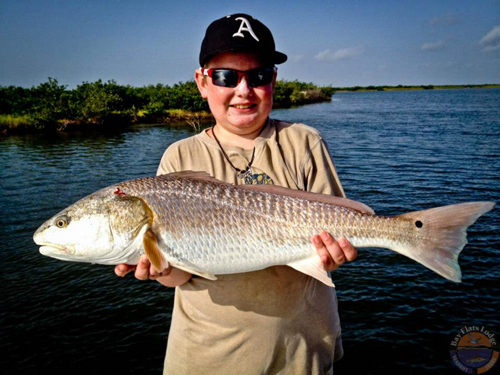
Will of Lakeway, Texas enjoyed landing reds on a very windy day in the back lakes of Matagorda Island with Bay Flats Lodge Guide Harold D. 8/15/12. All fish landed on cut mullet.
Recent lower tides from southwesterly winds have given me an opportunity to do something that I haven’t done in many years, and that’s search new fishing areas outside that of where I normally look for fish. Lower water levels often expose bottom structure that may not be visible to you in normal tides, so I decided to spend a few days over these past couple weeks exploring new territory and running a type of experiment, if you will, to test a couple of theories that I’ve formed over the years. I didn’t have a lot of time each day to perform my experiment, so I limited myself to no more than three hours each day for a period of four separate days. As a baseline for my tests, I attempted to pick four days that resembled each other as closely as possible in every way – same number of tides per day, same water conditions, same weather conditions…and so on. I wanted to test two different types of bottom structure, and I wanted to fish two different areas on different tides each day. Granted, it was a very crude effort on my part at a “true experiment”, but then again, I was more interested in satisfying my curiosity than anything else. So, off I went in search of new fishing grounds. I wanted to look in places where either I hadn’t fished in years and years, or that I had simply never fished at all. I dedicated an entire morning one day doing nothing more than riding around in the boat looking at different shorelines and their structure, some of which had now been exposed due to low water. It took me a while, but I finally picked two spots along a shoreline that I bet I haven’t fished in more than fifteen years, and I don’t know that I’ve ever fished in the exact two spots that I chose. Now that the test locations had been identified, it was now time to get started.
The two theories that I was going to test are strong beliefs of mine that I have formed after decades of fishing our coastal bend area. The first theory is that when bay waters heat-up in summertime, trout tend to lean more toward hard-sand shorelines instead of those lined with mud. The second theory I would be attempting to prove to myself is that I always seem to have better summertime luck whenever there is a presence of some amount of shell, regardless of whether it’s only a minimal amount, over that of fishing in heavily grassed areas.
Day one landed me in the first of the two places I had chosen for my test. It was a huge flat covering acres and acres of fairly soft sand covered with grass that was probably almost a foot tall in places. The water depth upon this flat went from nothing near the bank to nearly neck-deep some two-hundred yards off the shore. In between were guts running parallel to the shoreline that ranged from only inches in depth to sometimes one or two feet. It was mid-morning and a minor outgoing tide had just settled in as I started fishing. I spent a little more than my three hour limit in this area just because of the vastness of the flat. I wanted to make sure I could say in the end that I gave the area a fair shake. Fishing results that morning were good. By “good” I mean that I actually caught a lot of trout in many different places on that grass flat. However, all but just a couple of those fish were undersize.
Day two placed me in my second test spot about five miles down the same shoreline from where I fished on day one. Today’s location was completely different. The bay floor was hard sand and there were not any noticeable guts to mention. The sandy area tapered away from the bank much more rapidly than the previous grass flat area, and I could feel small clumps of oyster shell beneath my boots every few steps. Because of the day’s outgoing tide schedule, I was fishing a couple hours earlier in the morning today. I spent a little over two hours there that day and decided to head home after not catching even one undersize trout the entire time I was.
Day three put me back at the grass flat, but during an incoming tide that was closer to mid-day hours. On day four I was walking the hard-sand shoreline again during a rising tide that began just after lunch. My fishing results for days three and four lined-up almost identical with that of days one and two, with the only difference being that the numbers of small trout that I caught atop the grass on day three decreased a bit over that of day one. Whether I proved anything to myself may still be inconclusive, but I certainly had a blast putting my theories to the test.
It’s really, really hot out on the water right now, so please keep in mind the importance of you hydrating early, and often. And the same holds true for sunscreen. Always remember to apply your protection before you even get on the boat, and then re-apply throughout the course of the day. We hope everyone is having a wonderful summer vacation, and we remind your to practice CPR, “Catch, Photo, and Release”, whenever possible on trophy Trout and Reds…Guide Chris Martin, Port O’Connor/Seadrift region.
